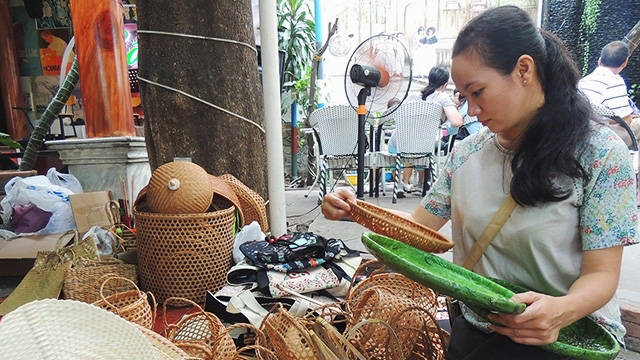


|
Visitors are choosing products at the market. Countryside market at a coffee shop
Every Sunday morning, a lot of people visited the ‘Sau’
coffee shop in Phu Nhuan District, Ho Chi Minh City to enjoy the familiar
atmosphere of a countryside market. Detached from the bustling world outside,
this market is not noisy despite the large number of visitors. With only ten
small pavilions, the market introduces different kinds of products, from
vegetables, onions, chilis and peppers, to oranges and tangerines. Numerous
traditional cuisines from all provinces and cities around the country are also
sold at the market, including Binh Dinh banh beo (water fern
cake), tau hu (tofu) from the central region, and familiar
noshes from the southern region.
Nguyen Van Thiep, a resident from District 1, Ho Chi Minh
City, said that: "This stall reminds me of my childhood when my family lived
in Hue city. Every afternoon, I followed my sisters to the front of my house
to wait for a walking tofu concession. The taste of ginger and yellow sugar,
along with the smell of hot tofu, made an unforgettable flavour.”
In addition to clean and safe food, the market introduces
unique works from famous trade villages. Pavilions displaying handicrafts
made of bamboo, water hyacinth and lotus, as well as incense, frankincense
and green tea, are placed in the middle of the market. Notably, visitors can
purchase and learn about Ma Chau silk products from a traditional trade
village in Quang Nam province. Ao dai (traditional
Vietnamese long dresses), ao ba ba (southern women’s
traditional costume) and even doll clothes are made of natural silk,
attracting the attention of many people.
Opening a market for love connection
The most special feature of this market is the purpose of
its formation and directions for development. Nguyen Thanh Thuy, head of the
Mothers’ Club, said that: "In addition to introducing people to the
specialities of localities from around the country, the market aims to
contribute to preserving the beauty of trade villages. We had to travel to
many trade villages from the central to southern provinces to learn about and
select products for the market. Visiting the villages, we understood more
about the enthusiasm and dedication of the artisans and villagers who are
trying to preserve their national cultural identities. Opening up the market,
we wish to help families to maintain the good habits of going to the market,
chatting and learning interesting things together. In modern life, the fun
moments enjoyed between family members are highly valuable.”
Notably, the heart of sharing from mothers and their
children in the club has created the specialty of the market. They provide
clean food which was planted, made and found by themselves. Mothers have
taught their children how to earn money thanks to their own labour and they
have also opened courses on the green lifestyle and environmental protection
for children.
Especially, they voluntarily contribute 10%-15% of the
revenues from the market to charitable activities to help children in remote
areas and farmers living in difficult circumstances in poor localities.
Instead of resting or going out, the mothers and their families decided to do
meaningful things at the weekend. After a few weeks, the amount of money
collected from the market has been converted into books for children and
items for sex education for girls, as well as tuition fees and scholarships
for children living in difficulties.
They also used an extracted amount to buy seed avocadoes
and goats for many ethnic minority families in a difficult mountainous
district in Lam Dong province. Along with the income from the market, the
mothers called for donations from their relatives and friends to extend the
range of their support programmes.
Source: NDO
|